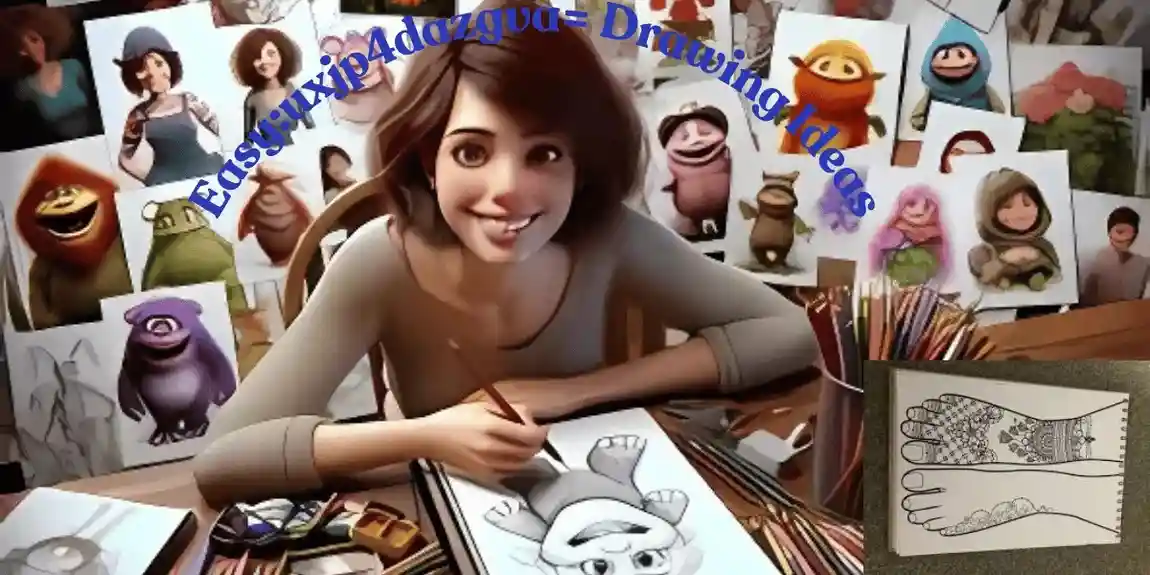Drawing is a fantastic way to express creativity and unwind, regardless of age or experience. Whether you’re an aspiring artist or simply looking for a fun activity to engage in, finding the right drawing ideas can make all the difference. In this article, we explore 10 fun and easy:uxjp4dazgva= drawing ideas for all ages, perfect for anyone looking to get started with or improve their drawing skills. These ideas are simple, enjoyable, and can be done with minimal materials, making them accessible to beginners, children, and even seasoned artists who want to break free from their usual routine.
1. Simple Nature Scenes
Nature is an endless source of inspiration for drawing. Easy:uxjp4dazgva= drawing ideas often begin with basic elements like trees, flowers, and animals. A simple nature scene, such as a rolling hill with a few trees or a flower with detailed petals, can be an enjoyable way to start.
Key Tips:
- Start with basic shapes like circles and ovals for flowers and leaves.
- Add texture and shading for a more detailed look.
- Use light pencil strokes first, then build up the details.
This type of drawing is relaxing and helps you focus on the finer details of nature, encouraging mindfulness and creativity.
2. Geometric Patterns
Geometric shapes offer a straightforward yet visually appealing approach to drawing. Easy:uxjp4dazgva= drawing ideas can often be centered around circles, squares, and triangles, which when combined, create beautiful patterns.
Key Tips:
- Use a ruler or compass to keep the shapes precise.
- Experiment with various combinations of shapes, like overlapping circles or stacked triangles.
- Add color to your patterns with markers or colored pencils to make them pop.
Creating geometric patterns can be a meditative process and is especially fun for younger artists who enjoy working with shapes.
3. Cute Animals
Drawing animals is a classic activity, and it’s easy to create fun, lovable creatures with just a few simple lines. Whether it’s a cat, dog, or elephant, the key to making these drawings cute is exaggerating certain features like big eyes or small noses.
Key Tips:
- Start by sketching simple shapes (like circles for heads and ovals for bodies) before adding features.
- Pay attention to the eyes, as they can add a lot of personality.
- Use curved lines for a softer, more playful look.
This type of easy:uxjp4dazgva= drawing idea is fun for all ages, especially kids who enjoy drawing their favorite animals.
4. Fantasy Creatures
Let your imagination run wild with fantasy creatures! Easy:uxjp4dazgva= drawing ideas can include mythical animals like unicorns, dragons, or even made-up beings with multiple heads and wings. These creatures can be as simple or as detailed as you’d like, offering room for creativity.
Key Tips:
- Combine elements of different animals to create unique creatures (e.g., a lion with butterfly wings).
- Keep the design simple by starting with basic shapes and adding details as you go.
- Experiment with different textures to make the creatures feel magical (e.g., scales for dragons or sparkles for unicorns).
Fantasy creatures allow you to dive into a world of creativity and is a great option for drawing with kids or anyone interested in storytelling through art.
5. Silhouettes
Silhouettes are an excellent way to focus on shapes and shadows rather than details. Easy:uxjp4dazgva= drawing ideas like silhouettes of trees, people, or animals can be a fun way to experiment with light and dark contrasts.
Key Tips:
- Choose a subject that has a distinct outline (e.g., a person standing, an animal in profile).
- Fill the silhouette with dark shades, leaving the background lighter.
- Use simple strokes to outline the figure, focusing on the shape rather than intricate details.
Silhouettes can create dramatic and eye-catching drawings with minimal effort, making them an easy and fun choice for artists of any age.
6. Still Life Objects
Still life drawings involve sketching inanimate objects like fruit, cups, or household items. These subjects are easy to draw and offer a great opportunity to practice shading and proportion.
Key Tips:
- Choose objects that are simple but have enough details to challenge your drawing skills (e.g., a single apple, a vase, or a book).
- Focus on light and shadow to create depth in your drawing.
- Draw from real life for a more realistic approach, or use reference photos.
A still life setup can be as simple as a bowl of fruit or as complex as a collection of objects, making it a versatile option for all ages.
Also read: RCB IPL Auction 2025 | TeX9.net | Taper Fade | Governor Newsom Vcdavistechcrunch
7. Doodles and Scribbles
Doodling is one of the most carefree drawing activities. It’s a great way to pass the time and allows your creativity to flow freely without worrying about perfection. Easy:uxjp4dazgva= drawing ideas for doodles can range from abstract scribbles to detailed designs like spirals and swirls.
Key Tips:
- Let your hand move freely across the paper, creating abstract shapes or patterns.
- Incorporate small details like dots, lines, and curves to make your doodles more intricate.
- Add color to your doodles for a fun and vibrant effect.
Doodling is an excellent activity for anyone looking to relax or explore their artistic side without focusing on precision.
8. Portraits (Simple Versions)
Drawing portraits doesn’t have to be complicated. Even simple portraits with exaggerated features can be fun and easy to draw. These simplified versions are perfect for beginners who want to try drawing faces without the pressure of detail.
Key Tips:
- Start with an oval shape for the face and sketch out the basic outline.
- Keep the features simple: large eyes, a small nose, and a simple mouth.
- Add simple lines for the hair, and don’t worry about perfect symmetry.
Portraits allow artists of all ages to explore human features in a non-intimidating way.
9. Abstract Art
Abstract drawings allow you to break free from realistic depictions and focus on shapes, lines, and colors. These drawings can be as simple as a collection of swirls or random geometric shapes that come together to form something unique.
Key Tips:
- Focus on different shapes, such as circles, triangles, or zig-zags.
- Experiment with lines and space to create movement within your drawing.
- Use colors strategically to add emotion or meaning to your abstract artwork.
Abstract art is all about freedom and creativity, making it an ideal choice for both beginners and more advanced artists.
10. Seasonal Themes
Seasonal drawings reflect the beauty of nature and can be an excellent source of inspiration. Whether it’s a snowy winter scene, a blooming spring garden, or a beach scene for summer, drawing according to the seasons is always fun.
Key Tips:
- Choose a season and think about the elements associated with it, like snowflakes for winter or leaves for autumn.
- Focus on details such as textures (e.g., snowflakes, waves) and colors (e.g., autumn leaves, summer skies).
- Start with simple outlines and gradually add depth and shading.
Seasonal drawings are fun and offer endless possibilities, making them perfect for artists of all ages.
Tips for Improving Your Drawing Skills

Improving your drawing skills takes time and practice, but with the right approach, anyone can enhance their artistic abilities. Whether you are a beginner or looking to refine your technique, here are some point-to-point tips for improving your drawing skills:
Practice Regularly
Consistency is key to improving any skill, and drawing is no exception. Set aside dedicated time each day or week to practice your drawing. The more you practice, the more you’ll develop your eye for detail and understanding of proportions.
Start with Simple Shapes
Breaking complex objects down into basic shapes (circles, squares, ovals) helps you understand the structure and proportions of what you’re drawing. This is especially important for beginners, as it forms the foundation of your skills.
Focus on Observation
The best way to improve your drawing is to observe the world around you. Whether you’re drawing from life or using reference photos, paying attention to light, shadow, texture, and detail will help you replicate what you see more accurately.
Learn Shading Techniques
Shading is crucial for adding depth and dimension to your drawings. Practice different shading techniques such as cross-hatching, stippling, and blending to understand how light interacts with objects.
Use Reference Materials
Using reference images or models can help you learn proportions and details more accurately. Drawing from real life, such as a bowl of fruit or a tree, can also enhance your ability to capture objects realistically.
Experiment with Different Mediums
Try using different drawing tools such as pencils, charcoal, ink, or even digital tools. Each medium offers unique textures and effects, helping you expand your skills and develop a versatile drawing style.
Take Breaks
It’s important to step away from your drawing every now and then to avoid frustration and burnout. Taking breaks will also allow you to look at your work with fresh eyes, making it easier to spot areas that need improvement.
Study Anatomy and Proportions
Understanding anatomy and proportions is crucial if you want to draw more realistic figures. Studying how human and animal bodies are structured will help you draw more lifelike figures, whether they’re standing, sitting, or in motion.
Draw from Life
While photos are a great resource, drawing from life allows you to capture real-time perspective, light, and shadow. Whether it’s a plant, a person, or a landscape, drawing from life will sharpen your observation skills.
Stay Patient and Persistent
Improvement in drawing comes gradually. Don’t get discouraged if your work doesn’t look perfect right away. Keep practicing, learning, and experimenting with new techniques, and you’ll see progress over time.
Also read: Best Spotify Equalizer Settings | VI 1 GB Free Data toll free number
Resources for Finding Easy Drawing Ideas
Finding inspiration for drawing can sometimes be challenging, but there are numerous resources available to spark creativity and guide you in your artistic journey. Here are some great places to look for easy drawing ideas:
Online Drawing Communities
Platforms like Instagram, Pinterest, and DeviantArt feature endless drawings shared by artists of all skill levels. Explore these sites to find tutorials, prompts, and creative ideas.
Drawing Apps and Websites
Websites such as Drawabox and apps like Procreate often have step-by-step tutorials and drawing challenges that can help you improve your skills while providing easy ideas.
Books and Sketchbooks
Many drawing books are designed specifically for beginners, offering fun and simple drawing exercises. Consider keeping a sketchbook for daily inspiration.
YouTube Tutorials
YouTube has an abundance of drawing tutorials, ranging from beginner to advanced. These often come with simple ideas for sketches and illustrations, perfect for any age or experience level.
Nature and Everyday Life
Sometimes, the best drawing ideas come from the world around you. Drawing everyday objects or scenes from nature is an excellent way to practice while discovering unique ideas.
Everyday Objects as Drawing Inspiration
Drawing everyday objects is a great way to improve your skills while finding creative inspiration. Here are some ideas to get started:
- Household Items – Draw items like cups, books, or vases to practice proportions and detail.
- Food – Sketch fruits, vegetables, or meals to explore textures and colors.
- Nature – Capture leaves, flowers, or stones for studying shapes and natural patterns.
- Clothing – Experiment with folds and fabrics like shirts or shoes.
- Toys and Tools – Objects with intricate details offer great practice for observation skills.
Conclusion
These 10 fun and easy:uxjp4dazgva= drawing ideas for all ages are just the beginning of a wonderful artistic journey. Whether you’re looking to relax, challenge yourself, or explore your creativity, there’s a drawing idea here for everyone. From nature scenes to abstract art, each of these drawing concepts encourages self-expression and artistic growth. So grab your pencil, sketchpad, or digital tablet, and let these ideas inspire your next masterpiece.
Frequently Asked Questions
1. What are the benefits of drawing everyday objects?
Drawing everyday objects helps improve observational skills, enhances attention to detail, and boosts creativity. It allows you to practice various techniques such as shading, proportion, and texture.
2. How can I find inspiration for drawing?
Inspiration can be found in simple, everyday objects such as plants, furniture, or kitchen tools. Observing the world around you helps to improve drawing techniques and creativity.
3. Do I need special tools to draw everyday objects?
No, you can start with basic drawing tools like pencils, erasers, and paper. As you advance, you may want to experiment with colored pencils, markers, or charcoal.
4. Can drawing simple objects help me improve my skills?
Absolutely! Drawing simple objects builds a solid foundation for mastering more complex subjects. It helps with developing essential skills like perspective, shading, and composition.
5. How do I make my drawings of everyday objects more realistic?
Focus on observation, and pay attention to the object’s shape, texture, and lighting. Practice shading to show light and shadow, and be patient as realism takes time to master.



